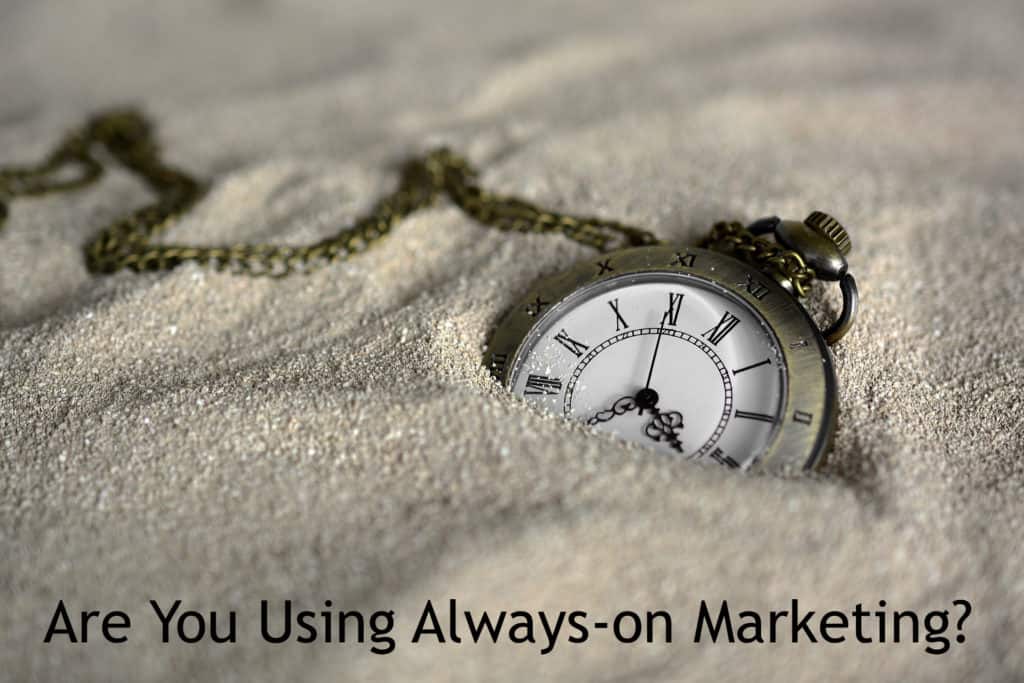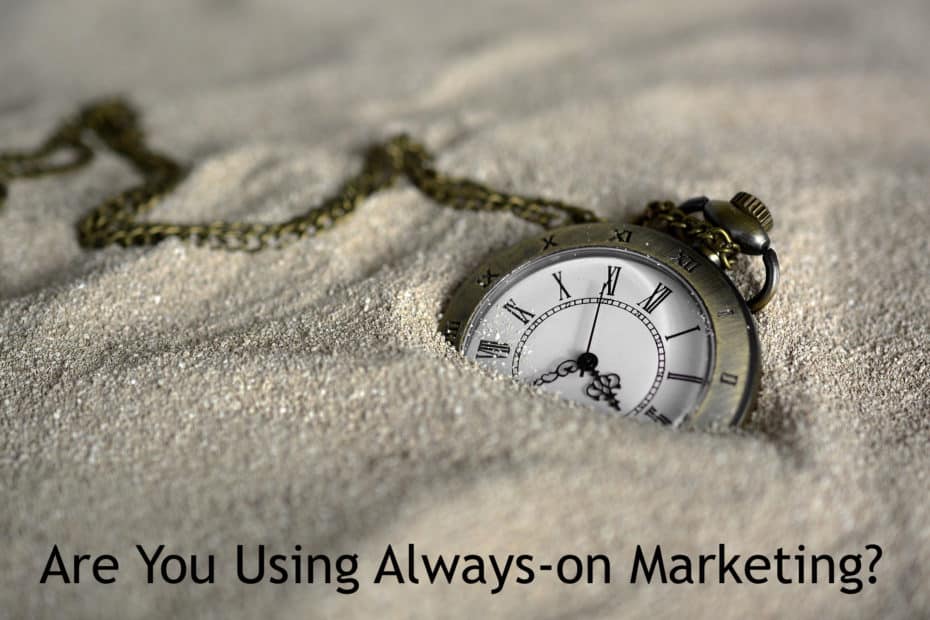
Always-on marketing isn’t a new concept but it is one that is often overlooked.
The question is why?
Maybe it’s because, like many of you, I like the big splashy idea and it’s something that a marketing campaign loves to throw at us.
There is more to marketing than this and big splashy ideas don’t grow on trees. Even they did, what appeals to you and what appeals to your potential customer are likely not the same.
We really need to spend more time focusing on the big picture and this is where always-on marketing plays.
It may not be sexy but if done right, it will get results that keep on giving.
That’s something we can all appreciate.
So, what is always-on marketing and how can it benefit you? Should you embrace it and dump marketing campaigns altogether or can they play together?
I’ll answer all these questions but let’s take a step back and start with what you are familiar with.
The Marketing Campaign
You’ve no doubt seen many marketing campaigns in your life.
Marketing campaigns typically focus on promoting something very specific such as awareness or to promote an idea.
They can run on multiple channels such as TV, print, radio, social media, search engine ads, and banner advertisements on websites, and billboards.
When I lived in Los Angeles it wasn’t uncommon to see movies advertised on less traditional mediums such as the benches at bus stops.
I still have clear memories of the movie Seven, starring Morgan Freeman and Brad Pitt, being advertised at what seemed like every bus stop in LA. It seemed impossible to get away from.
Marketing campaigns don’t typically have long life spans. They last a short period of time but there are exceptions.
The “Don’t squeeze the Charmin” campaign went on for over 20 years making Mr. Whipple one of the most recognized people in the United States.
The most common reason to run a marketing campaign is to create awareness.
Samsung announces a new smartphone and the marketing campaign drops with a slew of commercials promoting the product. As I’ve discussed in the past, if people aren’t aware of something, they certainly aren’t going to consider buying it.
Another popular reason for a campaign is to create interest.
You see this frequently as well. Especially with things such as movies. A new movie is coming out so a trailer is released. The idea of the trailer is to make you want to see the movie. It’s creating interest as well as awareness.
A couple of months ago, the trailer for The Eyes of Tammy Faye dropped. I was already aware that it was coming out but I didn’t really have any interest in it despite the fact that I love the acting of both Jessica Chastain and Andrew Garfield. After seeing the trailer, I remember thinking, “This actually looks really good. I might have to see this.”
One of my favorite all-time campaigns was the Get A Mac campaign that was intended to educate people on the differences between the Mac and the PC which ran from 2006 – 2009 running 66 commercials. I was actually disappointed when the campaign ended because I found the commercials so entertaining.
But of course, the reason the campaign ran for so long, like the Charmin campaign, is it got results.
It was reported that Apple saw a 39% increase in Mac sales in 2006 alone after the campaign started.
The pros of marketing campaigns are they are really good at driving both awareness and interest. And they can do other things such as educate people about your product/service.
The downside is a campaign won’t keep a customer if they don’t like the product or service.
Crystal Pepsi was a highly anticipated product in the early 1990s. The commercials that were created for the product used the song from Van Halen, “Right Now”, which was a huge hit even mimicking the style of the video the band had put for their song (which won some MTV Music Awards).
The problem was once people tried Crystal Pepsi, they didn’t like it. The issue wasn’t the marketing campaign. It did its job by creating massive awareness and interest. The issue was the product.
However, campaigns, regardless of how good they are always end.
This isn’t a bad thing, it’s just the nature of campaigns but there is another alternative.
What is Always-on Marketing?
A couple of years ago I wrote that marketing is an investment in the future. The idea being that your marketing isn’t something you should turn off and on.
Your marketing should be helping stabilize your business so you can avoid going through feast and famine cycles.
But, marketing isn’t like a faucet where when you turn it on and out come the customers. It takes time and not it’s not magic. It takes work.
If you only market when you need new customers, you’re likely to be disappointed. Because, as I said at the beginning, marketing is an investment in the future.
You’re marketing to those who have yet to become your customer.
If you blast them and disappear, they may not remember you but if your marketing to them on a continuous basis, you have a much better chance of being top of mind when they need what you sell.
This is why I like always-on marketing but what is it?
As the name implies, it means that your marketing never stops.
It is always active in some way, shape, or form. Hence the name, always-on marketing.
It’s your content marketing, your social media presence, your video channel, your podcast, speaking at conferences, and having webinars. It’s all those things you do that aren’t people normally think of when they think of marketing, the commercials.
The approach is usually more subtle because you aren’t always necessarily pushing people towards something to buy.
The goals of always-on marketing tend to be less focused on selling a product or service and more on building awareness, trust, and interest.
If you notice, this is really similar to what you would do in a campaign. The difference is with a campaign you are really trying to sell something more specific where your always-on marketing is working to build a relationship between you and your customer.
Let me give you an example.
The Charmin campaign was trying to sell the benefits and values of using Charmin.
If Charmin was engaging in always-on marketing, they would be trying to influence the way you felt about them as a company. A subtle but important difference. People do business with those they like and trust.
The campaign introduces you to the product.
Always-on marketing introduces you to the company first, works to build trust, and then talks about the product to build interest.
To put it another way, campaigns are more transaction-driven while always-on marketing is more relationship-driven.
The marketing is always active. It’s always working and being adjusted.
If you don’t have a strategic marketing plan, it can become difficult because always-on marketing needs structure around it.
There are always people who are becoming aware of you, being given information to build trust and interest. Those are three distinct stages so having a plan becomes extremely important.
A campaign is saying, “We sell this. Try it and you’ll love it.”
Always-on marketing takes longer to get there because there is also a focus on building the relationship so when you get to sell the product, it doesn’t feel as much like a sale anymore.
For those who are still there, it feels much more like the right choice because they have decided that they like and trust you.
The biggest potential con of always-on marketing is the amount of work that is being put into it. You have to show up and that can be an issue if the resources and people you need aren’t available to you.
Which One Should You Use
I’ve talked about both these options and you might be wondering which one is better. Which one is right for you.
They both have pros and cons.
I don’t see this as an article as having to pick between the two.
You should use both.
You need to always be marketing but there are times where there needs to be a campaign that focuses on something specific.
Campaigns are like an overlay onto your always-on marketing. If you’ve done it right, campaigns will show better results because of your always-on marketing.
I think of it this way. You are alive but you’re not always eating. You’re not always drinking something. You’re not always taking a shower.
There are certain times of the day when those activities have to happen but your being alive never comes into question (hopefully).
Let me end on this note.
I recently was watching a Twitter chat. The topic was how to generate a more consistent freelance income.
I decided instead of writing answers to the questions I was going to sit back and listen.
Lots of great ideas were given but the one that came up that we all were guilty of not doing was the same. Marketing all the time.
You see, even marketers sometimes forget that we should always be marketing too.
If you want to exit the feast and famine cycle your business is in or if you want to create a more stable financial environment for your company because the flow of customers is consistent, embrace always-on marketing.
Your business will thank you.
*Image by anncapictures from Pixabay
- The Importance of Creating a Connection With Your Marketing - June 6, 2024
- Reach vs Visibility: Which is Right for Your Marketing? - February 13, 2024
- Focus Your Marketing Efforts By Saying “No” - December 13, 2023

